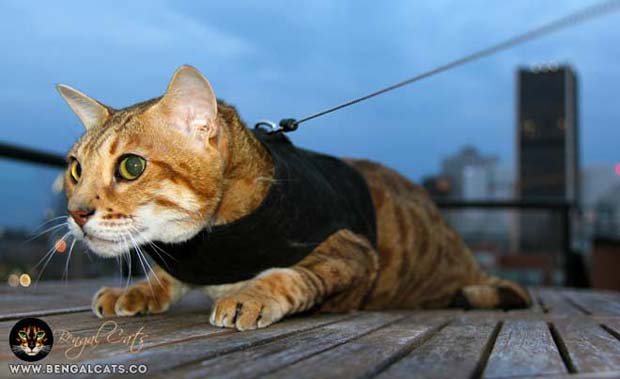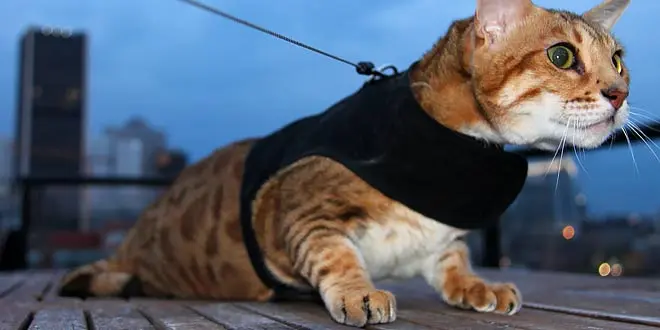[dropcap]I[/dropcap] recently bought the Kitty Holster cat harness for my Bengal after reading all the positive online reviews about this product. I was impressed with how well made it was and how easy it is to put on and take off. All the other harnesses I tried were so difficult and stressful to put on. This walking vest is also much more comfortable than the traditional 2-strap harnesses.
Compared to other cat harnesses, the Kitty Holster is ultra-lightweight and easier for your cat to wear. The harness is made of 100% breathable cotton to keep him comfortable. The Kitty Holster has no nylon, plastic clips or thin straps that can cause skin abrasion and uncomfortable pressure points. It is durable, machine washable and comes in a variety of beautiful colors and patterns.
Read the reviews on Amazon
I put the harness on yesterday in the house for a while. I then attached a retractable leash, and took my Bengal onto the rooftop terrace for his first outdoor experience. There was no struggle and he didn’t try to chew off or escape from this harness. In just a few days, my indoor cat now looks forward to some outside time! He is not ready for the city streets yet, but it’s important to take it slowly.
Follow these tips from Kitty Holster on how to train your cat to walk on a leash.
First Steps

The first step is getting your cat comfortable in the harness. Familiarize him with the harness by leaving it in your cat’s sleeping area for a few days.
Distract your cat with treats and be sure to praise him while you put the harness on.
To put the Kitty Holster on your cat, open the Velcro, place the harness over his back and close the collar and girth. Check to make sure that it fits comfortably, snugly but not tightly – if the harness is too loose or if there is a large flap on the collar or chest, you need a smaller size.
If your cat becomes stressed, speak to him in a friendly voice, take the harness off, and try again the next day. Don’t give up! He will eventually get used to it.
Attach a leash to the Kitty Holster. If your cat is timid or easily spooked, let your cat walk inside while keeping the leash slack and not restricting your cat’s movement.
Motivate him by taking it outdoors as quickly as possible. Open the door and ask: “Do you want to go outside for a walk?”. Be sure to have treats.
Walk Your Cat
Choose a safe location outdoors to walk your cat, ideally your front yard, back yard or in a quiet neighborhood or park. Stay away from the high traffic or crowded areas that can frighten him.
Keep the door open and give him time to get used to the outside world. A cat is not a dog: it can take weeks or months for him to feel safe in a new area!
If he is reluctant to move, try putting a treat on the ground next to your cat’s nose. After he finishes the treat, put another one on the ground about a foot away. Repeat until he is comfortable moving in the harness. You may initially have to gently lift your cat. Be sure to offer praise.
If he becomes alarmed and returns indoors, try again tomorrow.
SEE ALSO: Should I Let My Cat Outside? Especially a Bengal?
Always stand to the side and rear of your cat and use diagonal or sideways resistance to direct him. He will move in the direction of least resistance.
Create a signal that it is time to end the walk by telling your cat it is “Time to go home” followed by carrying him inside. Once indoors, offer him a treat immediately and remove the harness promptly.
Safety Tips
[tie_list type=”checklist”]
- Keep a bag of your cat’s favorite treats with you.
- During summer, make sure the ground isn’t too hot for his paws and take extra water.
- Hold the leash behind him. It is nearly impossible for a cat to back out of a Kitty Holster if the leash is behind the cat.
- Walk him in an enclosed yard or other safe area NOT near traffic or crowded areas. Night time is always better to avoid cars, people or dogs.
- Don’t let him chew on or lick anything. Substances that are common on city streets are potentially lethal.
- Take the time to train your cat to not attempt to back out of the harness. If your cat backs up, INSTANTLY slacken the leash and DO NOT give your cat something to pull against. After several repetitions your cat will stop attempting to pull out of the harness backwards. It is essential that you instantly and always slacken the leash. This is easier if you are standing behind the cat.
- Use and reinforce vocal cues such as “go”, “no”, “stop”, “inside” and “wait”.
- Use gentle reassurance by talking to your cat in a friendly tone. If he becomes alarmed, stroke his back at the base of the tail.
- If your cat starts to twist and roll to escape from the harness, do not try to pull him to you. Instead, slacken the leash, reach down and pet him to calm him down. If he was frightened by someone or something, calmly pick him up, walk away from the area, and consider calling it a day.
- If your cat escapes from the harness, stay calm. Sit on the ground, offer him a treat, and urge him to come to you using a friendly voice. When he comes to you, reach out slowly, pet him, and then calmly pick him up. If he starts to wander off, don’t take chase! Hearing you running behind will just make him run faster; instead, walk calmly and slowly, saying your cat’s name in a friendly voice. Stop when your cat stops, sit on the ground and offer him a treat to entice him to come to you.
[/tie_list]
[divider style=”solid” top=”15″ bottom=”15″]





